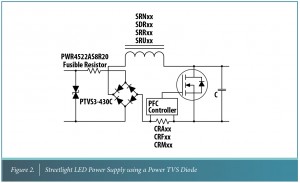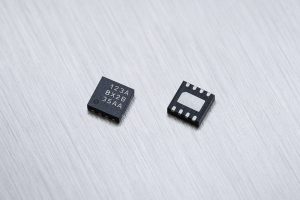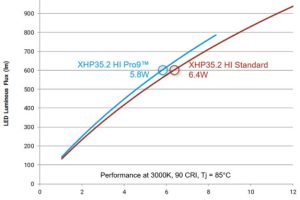The principle advantages of LED lighting are its long life, which can be as long as 60,000 hours, or 20 years, and inherent energy efficiency.
LED streetlights have been shown to use 15% of the energy and give off less heat, while generating more light per watt. LEDs do not contain toxic chemicals such as mercury compared to high-pressure sodium lamps or mercury-vapor lamps.
Because of their long lives, there are reduced maintenance costs and they offer additional benefits that include enhanced night visibility from increased color rendering, color temperature and brightness uniformity.
LED technology has had previous false starts where light output, reliability or temperature effects have not yielded the results expected.
With a reported 20% of global energy used for lighting, the energy cost and CO2 reduction advantages promised from LED technology has utilities and municipal services still positive on incorporating it for streetlights.
Most LED streetlight designs feature solid-state lighting luminaries configured in series strings of twenty or more LEDs. In this configuration, an open LED can cause the entire LED string to go dark, which leads to reliability, performance and maintenance concerns or costly warranty returns.
Adding an LED shunt protector (LSP) device to an LED string design allows the unaffected LEDs in the string to remain illuminated by shunting current around the inoperable LED.
For the remaining LEDs to continue working, an electronic shunt current bypass such as an LSP device provides a means to isolate open circuits, enabling current to flow uninterrupted through the LED string.
It doesn’t affect normal operation of the LED circuit, as the device is inactive, no current flows through the device and it only becomes active in the event of an open circuit.
LSP devices operate where the breakover voltage is proportional to the number of intended LEDs in a substring — high enough not to clip the forward voltage and lower than the open circuit LED voltage when the breakover current is drawn.
When the voltage across the device exceeds the rated breakover voltage, the LSP device switches to its “on” state, lowering the voltage to 1V. It minimises power dissipation and the maximum threshold voltage is 1.2V, which is less than the forward voltage of the LED.
 The LSP’s “off” state features a low standby current ensuring minimal system power loss. The LSP device’s required operating current must be less than the current consumed by an operational LED. Therefore, using a switched mode constant current supply actually reduces the luminaire power dissipation if an LED fails. To reliably switch on the LSP, the breakover current is specified below the minimum LED operating current and high enough to prevent false triggering.
The LSP’s “off” state features a low standby current ensuring minimal system power loss. The LSP device’s required operating current must be less than the current consumed by an operational LED. Therefore, using a switched mode constant current supply actually reduces the luminaire power dissipation if an LED fails. To reliably switch on the LSP, the breakover current is specified below the minimum LED operating current and high enough to prevent false triggering.
High-power LED designs that have typically used zener diodes can require very large, expensive zeners.
Certain LEDs do come equipped with an integral zener diode, but these diodes only provide ESD protection for the LED die, incapable of continuously handling the full operating current of the LED.
Integrated zener diodes are usually connected via the same wire bond as the LED die, so that when the wire bond fails, the zener diode typically is disconnected too.
An optimal configuration for a streetlight luminaire is shown in Figure 1. If the power is accidentally reversed during installation, using this configuration, the forward diode characteristic will protect the LED string from damage, while also protecting against fast transients at the power terminals.
In highly stressed LED strings, LEDs can develop an open circuit state. This is often a result of repeated cooling and heating stresses inside an LED package. Using an LSP device helps to maintain illumination in the remaining LEDs in the string if an LED goes into an open circuit state as a result of electrical or thermal damage.
A multi-LED streetlight uses a modern switching inverter to drive it, which introduces additional design challenges. To maximize operational life, LEDs must have effective current control and also maintain the expected light output.
The latest robust, small form factor and high-frequency switching inverters are needed to perform power factor correction and precise current control to maintain reliable operation in harsh environment streetlight installations. Recent developments that interconnect streetlights either by RF radio links or wired control lines for a system control approach and built-in intelligence requires more sensitive high-value circuits, which need to be protected from lightning and AC events and faults.
An effective high-current LED streetlight circuit protection solution is a PowerTVS (PTVS) diode offering bidirectional protection up to 470V, and some diodes also meet IEC 61000-4-5 8/20 μs surge requirements. Today’s advanced PTVS products provide lower clamping voltage under surge compared to competing varistor technology.
 The configuration of a typical streetlight LED power supply using a high PTVS diode (PTVS) instead of a more common varistor is illustrated in Figure 2.
The configuration of a typical streetlight LED power supply using a high PTVS diode (PTVS) instead of a more common varistor is illustrated in Figure 2.
Tight current sensing control can be achieved with current sense resistor devices that meet very high accuracy, broad operational temperature tolerance and high power density requirements. These highly specialised resistors are capable of withstanding surges without a material change in the characteristics of the resistor.
Writer is Koenraad Rutgers, senior field application engineer at Bourns.
 Electronics Weekly Electronics Design & Components Tech News
Electronics Weekly Electronics Design & Components Tech News



